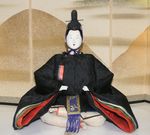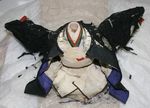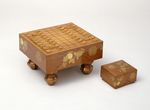Of the Owari Tokugawa Family 2022
←
→
Page content transcription
If your browser does not render page correctly, please read the page content below
The Tokugawa Art Museum Special Exhibition
The Hina Doll Festival
of the Owari Tokugawa Family 2022
From February 5 (Sat.) to April 3 (Sun.), 2022
Organized by
The Tokugawa Art Museum, Hōsa Library-City of Nagoya and
The Chūnichi Shimbun
The dolls and doll accessories that were made to order for the princesses of the Owari Tokugawa family have been
passed down to the Tokugawa Art Museum and all of them boast a high quality that is befitting the most senior rank
of the Tokugawa Shogun’s three branch families. Another highlight is the collection of Meiji, Taishō and Shōwa–era
displays overflowing with dolls and accessories and reaching as much as two meters high by seven meters wide.
Here, we introduce this world of the Doll Festival reaching heights of luxury and elegance achievable only in such a
household of the daimyo elite.
The Tokugawa Art Museum's Hina Doll Collection
Yūsoku-bina of Lady Kane-hime
The Tokugawa Art Museum has a large hina doll collection.
The most gorgeous sets of dolls belonged to Lady Kane-hime
(1831–1902), who married the 14th Lord of Owari, Tokugawa
Yoshikatsu (1824–1883), at the age of 19. It was customary
for a daimyo's daughter to bring her hina dolls with her when
she married into another daimyo family, so Kane-hime’s dolls
were passed down in the Owari Tokugawa family and eventually
came to the Museum.
All of Kane-hime’s hina dolls belong to the category of
yūsoku-bina. The term yūsoku means “manners and customs
of the imperial court,” and the dolls conform to the many rules
Yūsoku-bina, nōshi informal style
for the costumes, and hairstyles to be worn at court. The colors, (Hina dolls and five gagaku musicians)
materials and tailoring styles of the robes are determined
according to the position and age of the wearer as well as the season and occasion for which they are worn, and
yūsoku-bina beautifully copy those different court costumes. Five larger pairs of obina/male doll and mebina/female
dole (each more than 30 cm high) with a set of five musicians, and five smaller pairs of obina and mebina (about
10 cm high) with a set of three ladies-in-waiting and a set of seven musicians have been preserved. They represent
different types of costumes worn at the court, according to the rules of costume of the imperial household. Only
members of the upper strata of
society, such as imperial family
members, court nobles, or feudal
lords, were able to own yūsoku-bina,
because they were made by special
order and were very expensive.
Yūsoku-bina for privateMiniature Furnishings
Accompanying the Hina Dolls
Tessen-karakusa Maki-e Furnishings for Hina Dolls
These tessen-karakusa (arabesque with scrolled clematis design) maki-e
furnishings for hina dolls, which were produced around the end of 17th to the
beginning of 18th century, are the oldest in all doll furnishings collection of the
Tokugawa Art Museum. The original owner is not known, but kakeban (footed
tray) and hokai (a pair of picnic food boxes) were later held by Sachigimi, the Kakeban Stand for Tableware,
wife of 11th Owari Tokugawa Nariharu. clematis scroll design
Kiku-orieda Maki-e Furnishings for Hina Dolls of Lady Sachigimi
Lady Sachigimi (1820–1840) was an adopted daughter of the aristocratic Konoe family, and married the 11th Lord
of Owari, Tokugawa Nariharu, in 1836. Her belongings were decorated with shimmering lacquer maki-e (artistic
designs particularly in gold and silver), featuring the crests of both the Konoe and Tokugawa families as well as the
chrysanthemum, a felicitous symbol of longevity. Her trousseau, known as the
kiku-orieda (chrysanthemum-stems) maki-e furnishings, is one of the largest
extant in Japan today and constitutes one of the most precious holdings of the
Museum.
Miniature furnishings of her kiku-orieda trousseau were also ordered and
produced for Lady Sachigimi, each item being a fine copy of the actual furnishings
with the same designs.
In this exhibition, two set of shōgi boardgame, one from Sachigimi's
trousseau and the other from its miniature set, are on exhibit side by side.
Set of Shōgi Boardgame
Daki-botan-mon Chirashi Maki-e Furnishings for Hina Dolls of Lady Sachigimi
Lady Sachigimi had another set of miniature furnishings, which is lacquered
with designs of scattered peony-between-two-stems crests. Although the
actual hina dolls have been lost, with these miniature furnishings they must
have made gorgeous decorations for the Hina Festival in her household.
Norimono Palanquin
Shō-chiku-bai Karakusa Maki-e Furnishings for Hina Dolls of Lady Kanehime
This is another set of hina doll furnishings of Lady Kanehime, which is
designed with shō-chiku-bai (pine, bamboo and plum) and arabesque motif
on nashiji lacquer with silver fittings. The furnishings, consisting of more
than 80 items, vividly convey what marriage trousseau was like in those
days.
Shishuban Board for Incense Competition Game
Botan-karakusa Maki-e Furnishings for Hina Dolls
This furnishing set with botan-karakusa (peony scroll) design has been traditionally said to be a beloved belonging
of the 11th Tokugawa Shogun Ienari, and later came to be owned by Lady kanehime.
Tatewaku and Shō-chiku-bai Marumon Maki-e Furnishings for Hina Dolls
This furnishings for hina dolls has tatewaku (vertical wave motif) and shō-chiku-bai (pine, bamboo and plum motif)
design with colored lacquer and gold maki-e decorated on rosewood base, which adds dignity and gravity to the
small pieces. The owner, however, is not identified.The Hina Dolls and Furnishings after Meiji period
Hina Dolls of Three Generations
Exhibited on the largest platform in Exhibition Room 7 are the hina dolls and furnishings of three generations:
Meiji, Taishō and Shōwa eras. They were the dolls of Ms. Tokugawa Yoneko (1892–1980), wife of Yoshichika, the
19th head of the Owari Tokugawa and the founder of the Tokugawa Art Museum; those of Ms. Tokugawa Masako
(1913–1998), wife of Yoshitomo, the 20th head of the family; and those of Ms. Tokugawa Michiko (1936–), wife
of Yoshinobu, the 21st head of the family. On the top are several sets of dairi-bina (obina and mebina) and on
the lower stages are several sets of three ladies-in-waiting and five musicians, as well as a number of miniature
furnishings. Through these, one can see how the traditional Hina Doll Festival has been passed down from
generation to generation in Japan.
Hina Dolls of Princess Chichibu Setsuko
Princess Chichibu Setsuko (1909-1995) was born the eldest daughter of Matsudaira Tsuneo (1877-1949, pre-
war ambassador to the U.S. and U.K., Minister of the Imperial Household, post-war President of the House of
Councilors). She was also the grand-daughter of Matsudaira Katamori, an outstanding daimyo who was active
in the political scene toward the end of the Edo period. She married Prince Chichibu Yasuhito (younger brother
of Emperor Shōwa), and her younger sister Masako married Yoshitomo, the 20th-generation head of the Owari-
Tokugawa family. When Princess Setsuko passed away, her beloved hina dolls and miniature furnishings were
bequeathed to her younger sister, then in 1996 they were donated to the Museum. These dolls and furnishings
reflect the true quality of the belongings of the imperial family.
Hina Dolls Conservation Report
Hina dolls are difficult to maintain in sound condition over extended periods, as they are made of materials such
as silk and paper that tend to deteriorate over time. The courtly yūsoku-bina dolls belonging to Kanehime, which
have been exhibited in the annual doll displays, likewise had begun to show significant damage, particularly
with the deterioration of the head hair made of black dyed silk, and in the black costumes worn by the male
dolls. The main cause of this deterioration lies in the use of iron in the silk dyeing process. Over time and with
exposure to ultraviolet light, the iron component remaining in the fabric induces a chemical reaction, resulting in
the degradation and pulverization of the silk fibers.
In 2021, the museum decided to put into restoration work one of the male dolls showing particularly
severe damage, with the intent of preventing further deterioration so that it could continue to be displayed in
future exhibitions. The black robe was resewn from new fabric, and the white, green, and red silks visible at the
collar and cuffs were rotated so that the less faded parts were visible. The doll’s hair was also redone in new
material, bringing back the dignity appropriate to the costumed figure.
This conservation
project was conducted with
the funds raised through the
Activities Support Fund and
carried out with the cooperation
of the Ōnishi Ningyō Honten
shop, through whom we
commissioned the task to the
costume specialist Mr. Inoue
Gafū, the hair specialist Mr.
Inoue Masayuki, as well as the
Sengiren Textile Conservation Condition of the textile After repair of
before repair clothes and hair
Studio.A GLOSSARY of Hina Doll Accessories
Awase-gai Kakeban
360 awasegai (shells for the shell-matching game) are Footed serving tray used in formal
contained in a pair of kaioke (shell containers). They were ceremonies. Dishes for one person are
once indispensable items in the trousseau of the Japanese placed on it.
nobility. Daimyo families made one set for princesses when
Kezukuri-ningyō
they were born, and made miniature sets for their hina dolls
when they married. Dolls of dogs, rabbits, monkeys
or other creatures, made of silk.
Daisu and Kaigu Most of the kezukuri-ningyō
Shelf with tea ceremony utensils including furo (brazier), exhibited here were owned
kama (teakettle), mizusashi (water jar), kensui (rinsing bowl), by Yoneko, wife of Yoshichika, the 19th head of the Owari
shakutate (vase for tea ladle) and futaoki (rest for kettle lid). Tokugawa family.
These utensils are set in place before the guests enter the Kyōsoku
tearoom. The host brings other utensils such as chaire (tea
For relaxing when seated. Armrest made up of long, flat board
container), chawan (tea bowl) and chashaku (tea scoop).
and two legs.
Then the host conducts the tea ceremony.
Mimi-darai
Fusego A hemispherical water basin with two ear-shaped handles.
Frames for scenting robes. To perfume clothes, an incense It was used for ohaguro, the application of black paint to
burner is placed inside the frames, and robes laid over them. the teeth of a married woman. The substance for blackening
teeth was dissolved on a watashikane board put across the
Goban and Goishi in Goke Pot
waterbasin.
Go is a game of strategy played by
two players placing black and white Nagamochi
goishi stones alternately on a 19×19 Long carrying chest to store and
grid-lined board, each attempting to transport clothes and furnishings.
encircle the opponent’s pieces. The Carried on the shoulders of two people Nagamochi and Yutan
miniature go board in the dolls’ accessories is very small in by a long pole inserted through two
size, and the go stones are too small to pick up by hand, so metal suspension fittings attached to both sides of the chest.
our curators always struggle in placing the goishi stones for
display. Despite the difficulty, however, the curators work with Sashi-daru
scrupulous detail in placing the stones, recreating the realism Pair of box-shaped containers for sake. It has a spout on the
and tension of the game for the exhibit. top.
Harai-bako (Kushi-bako) Santana
Harai-bako, usually stores 33 pieces of kushi combs, which A set of three cabinets, kurodana, zushidana, and shodana.
have varied fineness of teeth, as well as comb-cleaning-kits
(kushi-barai, tsubo-kushi-barai, etc.). Kushi-barai assembles
a toothbrush and tsubo-kushi-barai a shaving brush in their
shapes.
Hasamibako
Shodana, Zushidana, Kurodana,
A pair of chests for carrying clothes. Porters shouldered the a cabinet for a cabinet for a cabinet for
chest with a pole passed through the handles. writing utensils incense utensils toiletry articles
Hazō and Tsunodarai
Tabakobon
An ewer and wash basin with four grips. Two pairs of "tsuno”
Tobacco tray and smoking accessories including kiseru (pipe),
(horns) were used as handles for carrying the basin. They
tabakoire (tobacco case), haifuki (a pot for ashes), and hiire
were usually used together.
(a kind of brazier).
Hirobuta
Takimono-tsubo
A tray for clothing. Presents for guests were sometimes placed
A pot made of aloeswood, sandalwood, cloves, or other
on it.
material, for a mixture of kneaded incense. Takimono-tsubo
Hokai was covered with kuchiooi (a cloth to cover the mouth) and a
decorative net, and placed on a hexagonal or octagonal stand.
A pair of meal boxes for picnicking.
Inu-hariko / Inu-bako Yutan
A pair of dog-shaped boxes. These
Cover for long carrying chest (nagamochi), drawer (tansu),
are male and female dogs, which
and Chinese-style chest (karabitsu). Originally, yutan were
were meant to be displayed on
made of cloth or paper, and coated with oil, for protection
wedding days. They also served as amulets for children's
from rain and dust.
health and longevity.
Jikirō
Food-serving container.
© The Tokugawa Art Museum
Jinbako 1017 Tokugawa-cho, Higashi-ku, Nagoya, 461-0023
TEL: 052-935-6262 / FAX: 052-935-6261
A box for incense wood. Jinbako generally connotes a tray and
https://www.tokugawa-art-museum.jp/en/
some small boxes, with several kinds of incense wood stored
in them separately.You can also read



























































